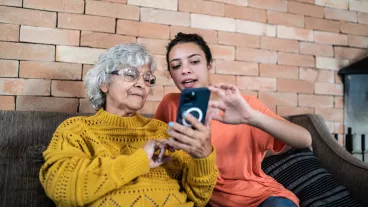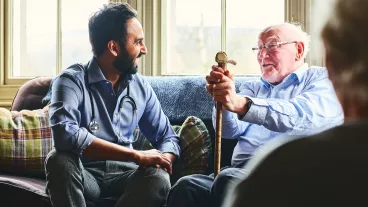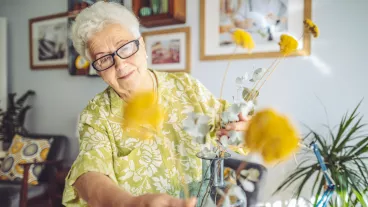Factors, dynamics and effects of isolation for older people
February 2024
Download Research snapshot
Social and geographical isolation
Isolation is a risk factor for elder abuse. The Australian National Elder Abuse Prevalence Study showed that lower levels of contact with family and friends was associated with a higher likelihood of experiencing elder abuse (Qu et al., 2021). Social and geographical isolation are of concern due to their impact on the wellbeing of older people.
Social and geographical isolation can be experienced separately or together.

Social isolation is an objective lack of connection and interaction with social networks, which can include family, friends and community.

Geographical isolation is marked by logistical and practical barriers to an older person's connection to and active participation in the community.
These barriers may be:
- financial
- related to limited transportation
- technological
- cultural and linguistic
- cognitive or related to other impairments.
Sources: Adorno et al., 2018; Beridze et al., 2020; Brooke et al., 2022; Byrne & Ghaiumy Anaraky, 2022; Herro et al., 2021; Holaday et al., 2022; Lamanna et al., 2020; Levasseur et al., 2020; Machielse & Duyndam, 2020; Pekmezaris et al., 2013; Winterton & Warburton, 2011.
Geographical isolation also affects older people's access to:
 | Health services |  | Financial services |
 | Social and community services |  | Legal and dispute resolution services |
Sources: Commissioner for Senior Victorians, 2020; Community Legal Centres Queensland Inc, 2019; Hunter & De Simone, 2009; Inder et al., 2012; Law Council of Australia, 2017; Longman et al., 2013; Parsons et al., 2021; van Spijker et al., 2019; Vine et al., 2020; Walsh et al., 2020; West & Ramcharan, 2019
How is isolation experienced by older people?
- Our findings indicated that experiences of isolation are characterised by ageism and social stigma around the ageing process.
- In previous research, older people have reported a tension between social isolation and the desire to maintain independence, which can reduce connection with others.
- The literature also showed that gender plays a role in experiences of isolation, with women more likely to engage in socially connecting activities than men.
- A lack of local opportunities, information and age-friendly infrastructure are barriers to engaging in the community.
- Interviews with service providers suggested that limited service capacity and accessibility to services in regional, rural and remote communities compounded the social isolation experienced by older people.
- Some service providers observed that geographical isolation exacerbated experiences of social isolation for older people.
What factors give rise to isolation?
Factors that give rise to isolation include:

| 
|

| 
|

| 
|

| 
|

| 
|

|
What are the effects of isolation on older people?
Our findings showed that the effects of isolation on older people were typically multiple and related to each other, including:
- poor personal or self-care
- decreased mobility
- decreased mood and memory
- apathy and reduced participation in previous areas of interest
- poor diet.
These multiple effects were observed by the professionals in this study, as illustrated in the following example:
So, what I have seen, people who are socially isolated, they don't eat well. And they may not be well-groomed because what is the point in getting dressed. I can be in my pyjamas all the time. 'I don't have to leave the house', and decreased mobility because they are not using their weight bearing muscles and bones to walk any distance. Decrease in mood and memory because of not having social interaction that will keep them sparked. Apathy, loss of interest in the usual hobbies and interests. (P01, public sector, rural)
Additional barriers for socially isolated people who were also geographically isolated were highlighted by some of the interviewees. The same service provider described how a client who had lost their partner was unable to access meal provision services because of their rural location but also had no incentive to prepare a meal when living alone:
If you've been living with somebody for many, many years and they passed away, it's very difficult to make that adjustment … and if you're eating on your own, we've seen the people tend to not eat a lot or they skip meals or have very, very simple meals, because what's the point in preparing a meal for just myself. (P01, public sector, rural)
How can we improve services and supports to meet the needs of isolated older people?
Individual and group interviews indicated that service providers:

used formal screening tools (e.g. Modified Monash Model scale to measure geographical isolation) and informal approaches (e.g. developing connections in the community) to identify isolated older people

suggested that adapting the My Aged Care portal to make navigation simpler would be beneficial for older people seeking support

identified that health care providers (such as general practitioners) need further support to identify isolated older people

suggested that councils and organisations could work to provide a sense of community and inclusion for older people.
Summary
- Social and geographical isolation are significant features in the lives of older people and these experiences are negative for their health and wellbeing.
- Significant life events and transitions, health and the stigma associated with ageing were identified as key factors giving rise to isolation for older people.
- The effects of isolation observed by service providers included loss of memory, poor self-care, decreased mobility and reduced engagement in previous activities of interest.
- A focus on prevention would help to improve quality of life for older people and those who care for them.
- Avenues identified to support older people and to decrease the effects of isolation included awareness-raising activities that reframe the need for social connection for older people, and offering clear options to seek social engagement.
- Interview participants suggested a review of the accessibility of the My Aged Care portal for older people and their carers was needed. They also suggested activities at the local community level have the potential to improve services and support.
About this study
Seniors Rights Service commissioned the Australian Institute of Family Studies (AIFS) to undertake an exploratory, qualitative study to examine the factors, dynamics and effects of isolation experienced by older people in New South Wales. The study was based on a desktop review and qualitative interviews with professionals.
This snapshot briefly summarises key findings from the desktop review of Australian and international literature relating to experiences of isolation among older people. It also provides relevant insights from individual and group interviews with 20 professionals who work with older people in a variety of settings.
This report was commissioned by Seniors Rights Service and funded by the NSW government.
Get more information about the Senior Rights Service
Access the full report:Factors, dynamics and effects of isolation for older people: an exploratory study.
References
Adorno, G., Fields, N., Cronley, C., Parekh, R., & Magruder, K. (2018). Ageing in a low-density urban city: Transportation mobility as a social equity issue. Ageing & Society, 38(2), 296-320.
Beridze, G., Ayala, A., Ribeiro, O., Fernández-Mayoralas, G., Rodríguez-Blázquez, C., Rodríguez-Rodríguez, V. et al. (2020). Are loneliness and social isolation associated with quality of life in older adults? Insights from Northern and Southern Europe. International Journal of Environmental Research and Public Health, 17(8637), 8637-8637.
Brooke, J., Dunford, S., & Clark, M. (2022). Older adult's longitudinal experiences of household isolation and social distancing during the COVID-19 pandemic. International Journal of Older People Nursing, e12459.
Byrne, K. A., & Ghaiumy Anaraky, R. (2022). Identifying racial and rural disparities of cognitive functioning among older adults: The role of social isolation and social technology use. The Journals of Gerontology. Series B, Psychological Sciences and Social Sciences.
Chan, A., Raman, P., Ma, S., & Malhotra, R. (2015). Loneliness and all-cause mortality in community-dwelling elderly Singaporeans. Demographic Research, 32, 1361-1382.
Commissioner for Senior Victorians. (2020). Ageing well in a changing world. Melbourne: Commissioner for Senior Victorians.
Community Legal Centres Queensland Inc. (2019). Evidence & analysis of legal need. Brisbane, Qld: Community Legal Centres Queensland Inc.
Czaja, S., Moxley, J. H., & Rogers, W. A. (2021). Social support, isolation, loneliness, and health among older adults in the PRISM randomized controlled trial. Frontiers in Psychology, 12.
Del Pozo Cruz, B., Perales, F., Alfonso-Rosa, R. M., & Del Pozo-Cruz, J. (2021a). Bidirectional and dynamic relationships between social isolation and physical functioning among older adults: A cross-lagged panel model of US National Survey data. The Journals of Gerontology. Series A, Biological Sciences and Medical Sciences, 76(11), 1977-1980.
Del Pozo Cruz, B., Perales, F., Alfonso-Rosa, R. M., & Del Pozo-Cruz, J. (2021b). Impact of social isolation on physical functioning among older adults: A 9-year longitudinal study of a U.S.-representative sample. American Journal of Preventive Medicine, 61(2), 158-164.
Dong-Kyun, P. (2017). Technologies to reach older persons with health-care services. Asia-Pacific Population Journal, 32(1), 75-103.
Ferrara, H. (2009). Seniors' social isolation: A scoping study. Retrieved from Perth, WA: Centre for Social and Community Research, Murdoch University.
Freak-Poli, R., Ryan, J., Tran, T., Owen, A., McHugh Power, J., Berk, M. et al. (2021). Social isolation, social support and loneliness as independent concepts, and their relationship with health-related quality of life among older women. Aging & Mental Health, 1-10.
Hajek, A., Brettschneider, C., Mallon, T., Kaduszkiewicz, H., Oey, A., Wiese, B. et al. (2021). Social support and health-related quality of life among the oldest old: Longitudinal evidence from the multicenter prospective AgeCoDe-AgeQualiDe study. Quality of Life Research: An International Journal of Quality of Life Aspects of Treatment, Care and Rehabilitation.
Herro, A., Lee, K. Y., Withall, A., Peisah, C., Chappell, L., & Sinclair, C. (2021). Elder mediation services among diverse older adult communities in Australia: Practitioner perspectives on accessibility. Gerontologist, 61(7), 1141-1152.
Hillier, M. (2007). Rebuilding connections: Creating opportunities for socially isolated older Australians: Evaluation of the Brotherhood of St Laurence Community Care Socialisation Program. Fitzroy, Vic: Brotherhood of St Laurence.
Holaday, L. W., Oladele, C. R., Miller, S. M., Dueñas, M. I., Roy, B., & Ross, J. S. (2022). Loneliness, sadness, and feelings of social disconnection in older adults during the COVID‐19 pandemic. Journal of the American Geriatrics Society, 70(2), 329-340.
Hu, J., Fitzgerald, S. M., Owen, A. J., Ryan, J., Joyce, J., Chowdhury, E. et al. (2021). Social isolation, social support, loneliness and cardiovascular disease risk factors: A cross-sectional study among older adults. International Journal of Geriatric Psychiatry, 36(11), 1795-1809.
Hunter, R., & De Simone, T. (2009). Women, legal aid and social inclusion. Australian Journal of Social Issues, 44(4), 379-398.
Inder, K. J., Lewin, T. J., & Kelly, B. J. (2012). Factors impacting on the well-being of older residents in rural communities. Perspectives in Public Health, 132(4), 182-191.
Lamanna, M., Klinger, C. A., Liu, A., & Mirza, R. M. (2020). The association between public transportation and social isolation in older adults: A scoping review of the literature. Canadian Journal on Aging / La Revue Canadienne du Iieillissement, 39(3), 393-405.
Law Council of Australia. (2017). The Justice Project: Older persons. Consultation paper. Braddon, ACT: Law Council of Australia.
Levasseur, M., Routhier, S., Clapperton, I., Doré, C., & Gallagher, F. (2020). Social participation needs of older adults living in a rural regional county municipality: toward reducing situations of isolation and vulnerability. BMC Geriatrics, 20(1), 1-12.
Longman, J., Passey, M., Singer, J., & Morgan, G. (2013). The role of social isolation in frequent and/or avoidable hospitalisation: rural community-based service providers' perspectives. Australian Health Review: A publication of the Australian Hospital Association, 37(2), 223-231.
Machielse, A., & Duyndam, J. (2020). Strategies of socially isolated older adults: Mechanisms of emergence and persistence. Journal of Aging Studies, 53, 100852.
Paine, N., Rachele, J. N., & Turrell, G. (2022). Sociodemographic characteristics and social exclusion among the oldest old. Australasian Journal on Ageing, 41(4), 563-572..
Parsons, K., Gaudine, A., & Swab, M. (2021). Experiences of older adults accessing specialized health care services in rural and remote areas: a qualitative systematic review. JBI Evidence Synthesis, 19(6), 1328-1343. doi:10.11124/JBIES-20-00048
Pekmezaris, R., Kozikowski, A., Moise, G., Clement, P., Hirsch, J., Kraut, J. et al. (2013). Aging in suburbia: An assessment of senior needs. Educational Gerontology, 39(5), 355-365. doi:10.1080/03601277.2012.700849
Qu, L., Kaspiew, R., Carson, R., Roopani, D., De Maio, J., Harvey, J. et al. (2021). National Elder Abuse Prevalence Study: Final report. Melbourne: Australian Institute of Family Studies.
Plath, D. (2008). Independence in old age: The route to social exclusion? British Journal of Social Work, 38(7), 1353-1369.
Saito, M., Aida, J., Cable, N., Zaninotto, P., Ikeda, T., Tsuji, T. et al. (2021). Cross-national comparison of social isolation and mortality among older adults: A 10-year follow-up study in Japan and England. Geriatrics & Gerontology International, 21(2), 209-214. doi:10.1111/ggi.14118
Santini, Z., Fiori, K. L., Tyrovolas, S., Haro, J. M., Feeney, J., & Koyanagi, A. (2016). Structure and function of social networks, loneliness, and their association with mental disorders among older men and women in Ireland: A prospective community-based study. European Psychiatry, 33(Supplement), S178-S179. doi:10.1016/j.eurpsy.2016.01.381
Schrempft, S., Jackowska, M., Hamer, M., & Steptoe, A. (2019). Associations between social isolation, loneliness, and objective physical activity in older men and women. BMC Public Health, 19(1), 1-10. doi:10.1186/s12889-019-6424-y
van Spijker, B. A., Salinas-Perez, J. A., Mendoza, J., Bell, T., Bagheri, N., Furst, M. A. et al. (2019). Service availability and capacity in rural mental health in Australia: Analysing gaps using an Integrated Mental Health Atlas. The Australian and New Zealand Journal of Psychiatry, 53(10), 1000-1012. doi:10.1177/0004867419857809
Vine, D., Buys, L., & Aird, R. (2014). Conceptions of 'community' among older adults living in high-density urban areas: An Australian case study. Australasian Journal on Ageing, 33(2), 1-6.
Walsh, K., O'Shea, E., & Scharf, T. (2020). Rural old-age social exclusion: A conceptual framework on mediators of exclusion across the lifecourse. Ageing & Society, 40(11), 2311-2337. doi:10.1017/S0144686X19000606
West, R., & Ramcharan, P. (2019). The emerging role of financial counsellors in supporting older persons in financial hardship and with management of consumer-directed care packages within Australia. Australian Journal of Social Issues, 54(1), 32-51. doi:10.1002/ajs4.55
Winterton, R., & Warburton, J. (2011). Models of care for socially isolated older rural carers: Barriers and implications. Rural and Remote Health, 11(3), Article 1678.
Media releases
© GettyImages/Liam Bell
Stevens, E., Carson, R., & Wall, L. (2023). Factors, dynamics and effects of isolation for older people. Melbourne: Australian Institute of Family Studies.
Download Research snapshot
Related publications

Factors, dynamics and effects of isolation for older people…
This report sets out the findings of the Factors, Dynamics and Effects of Isolation for Older People: An Exploratory…
Read more
Social isolation: Factors, dynamics and effects of…
This snapshot discusses social isolation for older people being an objective lack of connection and interaction with…
Read more
Geographical isolation: Factors, dynamics and effects of…
This snapshot briefly summarises the barriers to accessing services and supports for geographically isolated older…
Read more